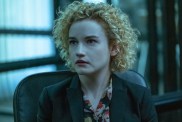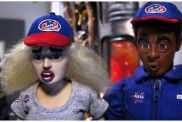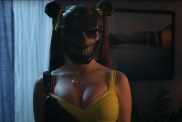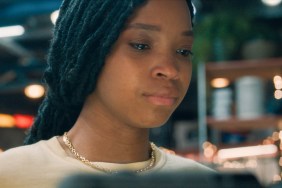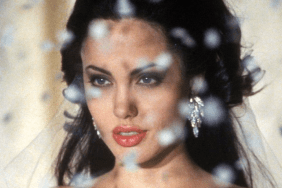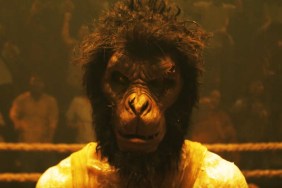“I’ll take that as huge compliment,” Angelina Jolie smiles to a reporter who has just likened her turn in this week’s Maleficent to Gloria Swanson’s iconic Norma Desmond in Sunset Blvd. “I think that was part of the thing with this role. You realize that there’s no halfway. That if you’re going to do it, you can’t kind of do it.”
Last week, ComingSoon.net joined a small roundtable of journalists for an extended conversation with Jolie who, in the year and a half since production, has gone on to direct her second feature film, this December’s Unbroken. We were there, though, too, at Pinewood Studios in August of 2012, standing with another small group of press when, quite surprisingly, the film’s star appeared before us in full costume.
“I think I look better as her,” the dark fairy told us with a smile that day. “I do! When my stuff?s off, I feel very flat. She?s so much bigger than life that I feel quite dull in comparison to her.”
The scene being filmed on a massive outdoor stage involved Maleficent standing on the outskirts of Stefan’s castle, walking alongside a great black horse covered in feathers. In the story, that horse is actually a transformed version of Maleficent’s crow, Diaval (played in human form by Sam Riley).
“Sam is many, many things,” the horned woman laughed, still half in character. “We never know which day on set is Sam or an animal. We often confuse them! He actually can’t begin a scene until I’ve turned him back into a man. When we’re waiting for him to begin a scene, we’re really waiting for me to turn him into a person.”
“[T template=’galleryview’]–>he artist in me felt it’s good to do something bold every once in a while,” Jolie, sans horns, recalls a year and a half later. “?[It was template=’galleryview’]–> such a crazy idea and I was so challenged by it. My kids are now all watching all these movies and wanting to play with mommy. It was perfect timing to have them all on set, playing, being a part of the adventure with me and for me as an actress to not do something where I?m taking myself so seriously? Just remember what it is to play and entertain and try something bold.”
Also an accomplished screenwriter, producer and director, Jolie is well aware of the inherent silliness in bringing a familiar animated character to life.
“You know, I was a bit nervous to take her on?” she recalls. “I just thought — I don’t have a big theater voice. I don’t do things that are kind of comedic. ?This is such a crazy idea! I’m a fairy, you know? I’d come home and [it’s template=’galleryview’]–>, ‘how was your day honey?’ ‘I was a fairy!”
Jolie’s own daughter, Vivienne Jolie-Pitt, makes a brief-but-memorable appearance in the film as a pre-school age Princess Aurora (played by Elle Fanning later in the story). It’s not nepotism that won the young star the part, however. The Maleficent makeup (designed by the legendary Rick Baker) was so frighteningly realistic that the production had trouble finding another young girl that wasn’t terrified to be in the presence of Jolie’s fairy tale alter ego.
“I actually had one child completely freeze and then cry,” Jolie recalls. “It was like terror. I felt so bad. We realized that there was no way that we were going to find a four or five-year old that I could be as strong with that would not see me as a monster. Suddenly, there was Vivie running around looking like little Aurora.”
Beyond the sheer spectacle of it all, there’s also a deep emotional core to Maleficent.The film’s most powerful metaphor comes when Maleficent is betrayed by a loved one, who removes the fairy’s wings.
“What happened to her was more like a rape,” Jolie tells us at the roundtable, “Something that she had no choice in and something that was done with ill intent. I think people will see it and I think they will see. For children, it’s abuse. It?s being bullied. It’s being hurt. For anybody — everybody at this table — we?ve all had that moment where somebody really hurt us and it changed us.”
Essentially reminding children that, in the wake of understanding, hatred dissipates, Maleficent‘s story is, out of necessity, as emotionally dark at times as the villain it seeks to redeem.
“I think the depth of what children can handle and what they?re really interested in is much deeper than people assume,” she explains. “I think it?s why sometimes we make things too simple for them? People say, ‘Is it too dark for children?’ It?s not. They want to understand things that frighten them. They want to see dark things that happen and they want to see how to rise above them. They don?t want to be hidden from all things and have everything sweetened.”
Despite the sweetened appearance of the film itself, Jolie hopes that Maleficent‘s ultimate message will find resonance with even the youngest of moviegoers.
“It’ll upset them,” she admits. “but then they?ll also get angry with her, hopefully. Then they?ll also want her to grow past it. They’ll kind of go on that journey of understanding how you could ever evolve past that and what that is? When we can make stories for children that they can walk away with having thoughts about things they didn’t normally think about or learned a little something or felt heart warmed by something, then we’ve done something better.”
Maleficent opens in theaters in 2D and 3D tonight!
Maleficent
-
Maleficent

-
Maleficent

-
Maleficent

-
Maleficent

-
Maleficent

-
Maleficent

-
Maleficent

-
Maleficent

-
Maleficent

-
Maleficent

-
Maleficent

-
Maleficent

-
Maleficent

-
Maleficent

-
Maleficent

-
Maleficent

-
Maleficent

-
Maleficent

-
Maleficent

-
Maleficent

-
Maleficent

-
Maleficent

-
Maleficent

-
Maleficent

-
Maleficent

-
Maleficent

-
Maleficent

-
Maleficent

-
Maleficent

-
Maleficent

-
Maleficent

-
Maleficent

-
Maleficent

-
Maleficent

-
Maleficent

-
Maleficent

-
Maleficent

-
Maleficent

-
Maleficent

-
Maleficent

-
Maleficent

-
Maleficent

-
Maleficent

-
Maleficent

-
Maleficent

-
Maleficent

-
Maleficent

-
Maleficent

-
Maleficent

-
Maleficent

-
Maleficent

-
Maleficent

-
Maleficent

-
Maleficent

-
Maleficent

-
Maleficent

-
Maleficent

-
Maleficent

-
Maleficent

-
Maleficent

-
Maleficent

-
Maleficent

-
Maleficent

-
Maleficent

-
Maleficent

-
Maleficent

-
Maleficent

-
Maleficent

-
Maleficent

-
Maleficent

-
Maleficent

-
Maleficent

-
Maleficent

-
Maleficent

-
Maleficent

-
Maleficent

-
Maleficent

-
Maleficent

-
Maleficent

-
Maleficent

-
Maleficent

-
Maleficent

-
Maleficent

-
Maleficent

-
Maleficent

-
Maleficent

-
Maleficent

-
Maleficent

-
Maleficent


